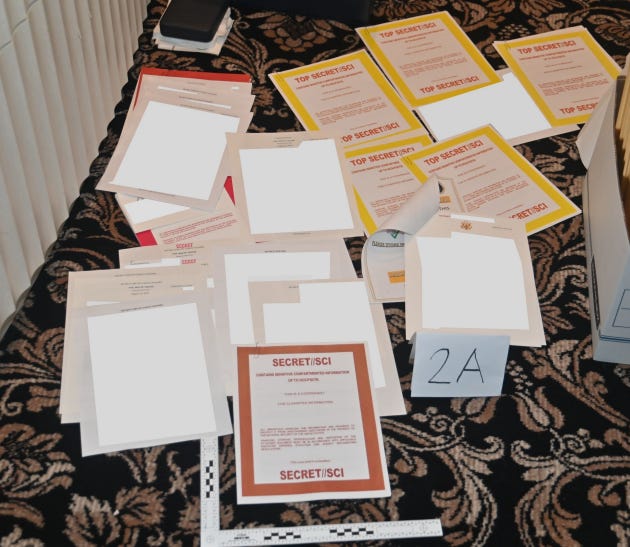New disclosures in Special Counsel Jack Smith's espionage case against Donald Trump reveal the FBI tampered with evidence to create the infamous photo--and DOJ has lied about it for nearly two years.

www.declassified.live
"The
New York Times insisted the photo was consistent with how the FBI handles criminal investigations. “[It] is standard practice for the F.B.I. to take evidentiary pictures of materials recovered in a search to ensure that items are properly cataloged and accounted for. Files or documents are not tossed around randomly, even though they might appear that way; they are usually splayed out so they can be separately identified by their markings,” reporters Glenn Thrush and Adam Goldman
wrote on August 31, 2022.
Except…that is not what happened.
A Stunt with Potentially Case-Killing Consequences for DOJ
New court filings in Special Counsel Jack Smith’s espionage and obstruction case against Trump and two co-defendants conclusively demonstrate that the government used the cover sheets to deceive the public as well as the court. The photo was a stunt, and one that adds more fuel to this dumpster-fire case.
Jay Bratt, who was the lead DOJ prosecutor on the investigation at the time and now is assigned to Smith’s team, described the photo this way in his August 30, 2022 response to Trump’s special master lawsuit:
“[Thirteen] boxes or containers contained documents with classification markings, and in all, over one hundred unique documents with classification markings…were seized.
Certain of the documents had colored cover sheets indicating their classification status. (Emphasis added.) See, e.g., Attachment F (redacted FBI photograph of certain documents and classified cover sheets recovered from a container in the ‘45 office’).”
The DOJ’s clever wordsmithing, however, did not accurately describe the origin of the cover sheets. In what must be considered not only an act of doctoring evidence but willfully misleading the American people into believing the former president is a criminal and threat to national security, agents involved in the raid
attached the cover sheets to at least seven files to stage the photo.
Classified cover sheets were not “recovered” in the container, contrary to Bratt’s declaration to the court. In fact, after being busted recently by defense attorneys for mishandling evidence in the case, Bratt had to fess up about how the cover sheets actually ended up on the documents.
Here is Bratt’s new version of the story, where he finally admits a critical detail that he failed to disclose in his August 2022 filing:
“[If] the investigative team found a document with classification markings, it removed the document, segregated it, and replaced it with a placeholder sheet. The investigative team used classified cover sheets for that purpose.”
But before the official cover sheets were used as placeholder, agents apparently used them as props. FBI agents took it upon themselves to paperclip the sheets to documents—something evident given the uniform nature of how each cover sheet is clipped to each file in the photo—laid them on the floor, and snapped a picture for political posterity.
That raises many troubling questions, to say the least, about the FBI’s handling of the alleged incriminating documents.
For example, who made the on-site determination as to the classification level appropriate for each document? Did agents have security clearance and expertise related to classification? Did the agents know whether the document had been declassified by Trump while still in office?
The hasty assessment also appears to contradict Bratt’s statements in court about the classification status of the seized documents. Bratt told Judge Aileen Cannon during a hearing last year that the records were undergoing a classification review, presumably conducted by the intelligence community, to determine the correct level of secrecy.
Did the final analysis confirm or dispute the assessments by the field FBI agents who conducted the raid?
Missing Paper Trial and Messy Boxes
But Jack Smith might have bigger problems. During the raid, agents took a box in its entirety if it contained papers with classified markings; the box usually contained other items, which is how the FBI ended up with so many of Trump’s personal belongings.
So, in order to flag the location of the alleged classified record in the box, agents, as Bratt noted, used the cover sheets as placeholders. (The classified records were then placed in a separate secure file.)
But now defense attorneys claim,
and the special counsel concedes, that some placeholders do not match the relevant document. “Following defense counsel’s review of the physical boxes…and the documents produced in classified discovery, defense counsel has learned that the cross-reference provided by the Special Counsel’s Office does not contain accurate information,” attorneys representing Trump’s co-defendant Waltine Nauta wrote in a May 1 motion."



